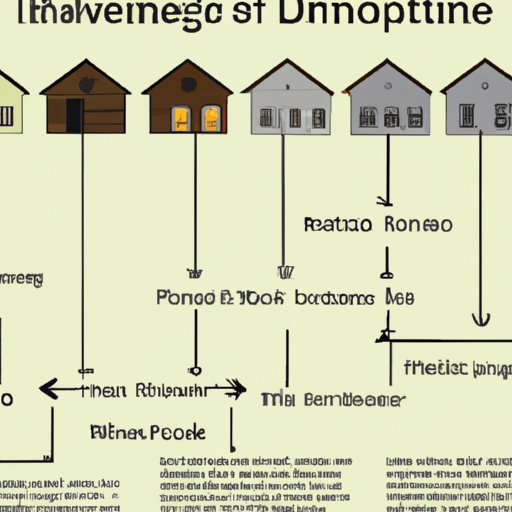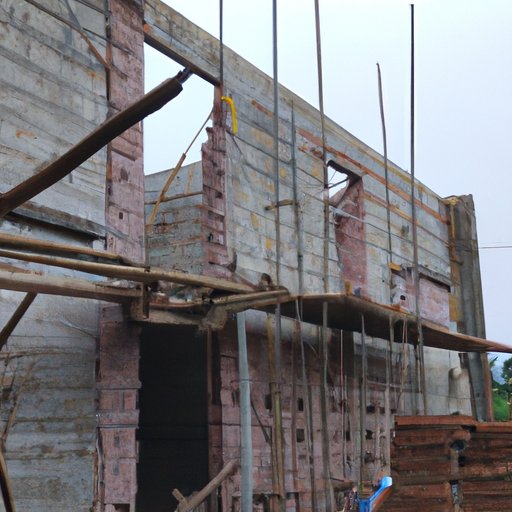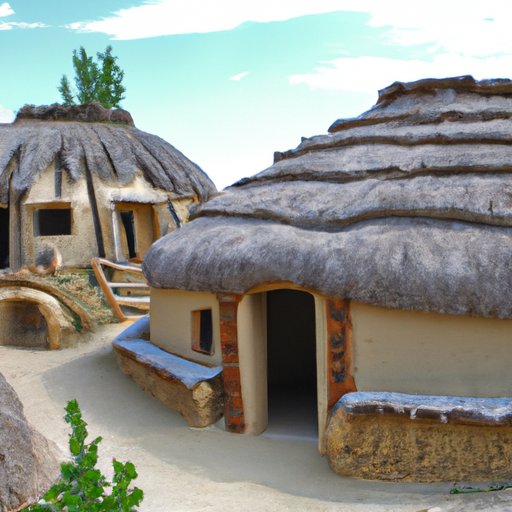Introduction
The word “house” is often used to describe a dwelling that provides shelter and protection from the elements. However, the concept of a house has evolved over time, with different societies developing their own unique styles of architecture and building materials. This article will explore the history of house development throughout the ages, from prehistoric times to today, examining traditional building materials used in early houses and comparing historic and modern houses. It will also look at the impact of human ingenuity on house design.

Historical Timeline of House Development
The earliest known houses were built by hunter-gatherer societies during the Paleolithic era, which spanned from 2.6 million years ago to 10,000 BCE. These prehistoric houses were made from natural materials such as animal skins, sticks, and stones, and were usually constructed in caves or rock shelters to provide protection against the elements.
In the Neolithic period (10,000-3,000 BCE), humans began domesticating animals and cultivating crops. They also began to build more sophisticated houses using stone, wood, clay, and other materials. These houses were designed to be more comfortable and efficient than the simple dwellings of the Paleolithic era. During this period, people also developed techniques for firing clay into bricks, which allowed them to construct larger and more complex structures.
By the Bronze Age (3,000-1,200 BCE), houses were becoming increasingly elaborate and were built with advanced techniques such as post and lintel construction. In many societies, these houses were decorated with carvings and paintings and were often surrounded by walls and towers for protection.
During the Iron Age (1,200-500 BCE), iron tools allowed builders to construct even more impressive houses. The use of iron also gave rise to new building techniques such as arches and domes. By the Classical period (500-323 BCE), houses had become even more luxurious, with innovative designs and grandiose features such as marble floors and ornate columns.
In the Middle Ages (500-1500 CE), the development of castles and fortifications led to a shift in house design. Houses were now built for both practicality and defense, with thick stone walls and fortified towers. By the Renaissance period (1400-1600 CE), houses had become more ornate and elaborate, with decorative features such as stained glass windows and intricate stonework.
In the modern day, houses are constructed from a wide variety of materials, including steel, concrete, brick, and glass. They are also designed with an emphasis on energy efficiency and comfort, making them much more livable than their predecessors.

Examining Traditional Building Materials Used in Early Houses
Throughout history, humans have used a variety of materials to construct their homes. Here we take a closer look at some of the most common building materials used in early houses.
Stone
Stone was one of the earliest building materials used by humans and was used to construct everything from small huts to large fortresses. Stone provided a durable and weatherproof material for building and could easily be shaped and molded into various forms.
Wood
Wood was another popular building material in early societies and was used to construct houses, barns, and other structures. It was relatively easy to work with and could be shaped into various forms, such as beams and posts. However, it was not as durable as stone and was susceptible to decay and rot.
Clay
Clay was also commonly used in early house construction. It was easy to work with and could be formed into various shapes and sizes. It was also fairly durable and provided good insulation against the elements.
Other Materials
In addition to stone, wood, and clay, other materials were also used in early house construction. These included straw, reeds, mud, and plaster. Each material had its own advantages and disadvantages, and builders often used a combination of materials to create sturdy and long-lasting structures.
A Comparative Study of Historic and Modern Houses
There are a number of differences between historic and modern houses. Here we compare and contrast the two types of houses, looking at their structural differences, design elements, and technology advancements.
Structural Differences
Historic houses were typically constructed using simple tools and materials such as stone, wood, and clay. They often had thick stone walls and small windows, which provided good insulation but limited natural light. In contrast, modern houses are typically constructed using more advanced tools and materials such as steel, concrete, and glass. They often have large windows and open floor plans, which provide plenty of natural light and a more spacious feel.
Design Elements
Historic houses were often decorated with carvings and paintings and featured ornate designs such as marble floors and intricate stonework. In contrast, modern houses tend to have a more minimalist aesthetic, with clean lines and neutral colors. Technology advancements such as air conditioning and heating systems have also allowed for more comfortable living spaces.
Technology Advancements
Historic houses relied on natural ventilation and lighting, while modern houses are equipped with sophisticated systems such as air conditioning and indoor lighting. Smart home technology has also allowed homeowners to control their environment remotely, from adjusting the temperature to locking the doors.

The Impact of Human Ingenuity on House Design
Throughout history, humans have been driven by a desire to create better and more efficient houses. Over time, they have developed innovative building techniques and creative uses of materials to create entirely new designs and concepts. Here we look at some of the ways human ingenuity has impacted house design.
Innovations in Building Techniques
Humans have come up with a range of innovative building techniques over the years. From post and lintel construction to steel framing, these techniques have allowed for the construction of larger and more complex structures. They have also enabled the creation of energy-efficient designs, such as passive solar homes.
Creative Use of Materials
Humans have also found creative ways to use traditional building materials. For example, clay can be fired into bricks to create strong and durable structures, while wood can be carved into decorative elements such as furniture and trim. Today, materials such as steel and concrete are being used in new and innovative ways.
New Designs and Concepts
Finally, human ingenuity has allowed for the development of entirely new designs and concepts. From prefabricated homes to tiny houses, these new designs offer a range of benefits such as affordability, sustainability, and mobility. They have also opened up new possibilities for how we live our lives.
Conclusion
From prehistoric huts to modern smart homes, the history of house development is a testament to human ingenuity and creativity. Throughout the ages, humans have devised innovative building techniques and creative uses of materials to create entirely new designs and concepts. From castles to tiny houses, these advances have allowed us to live more comfortably and efficiently than ever before. As we continue to push the boundaries of house design, it is exciting to think of what the future holds.
(Note: Is this article not meeting your expectations? Do you have knowledge or insights to share? Unlock new opportunities and expand your reach by joining our authors team. Click Registration to join us and share your expertise with our readers.)
